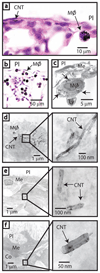Inhaled carbon nanotubes reach the subpleural tissue in mice
- PMID: 19893520
- PMCID: PMC2783215
- DOI: 10.1038/nnano.2009.305
Inhaled carbon nanotubes reach the subpleural tissue in mice
Abstract
Carbon nanotubes are shaped like fibres and can stimulate inflammation at the surface of the peritoneum when injected into the abdominal cavity of mice, raising concerns that inhaled nanotubes may cause pleural fibrosis and/or mesothelioma. Here, we show that multiwalled carbon nanotubes reach the subpleura in mice after a single inhalation exposure of 30 mg m(-3) for 6 h. Nanotubes were embedded in the subpleural wall and within subpleural macrophages. Mononuclear cell aggregates on the pleural surface increased in number and size after 1 day and nanotube-containing macrophages were observed within these foci. Subpleural fibrosis unique to this form of nanotubes increased after 2 and 6 weeks following inhalation. None of these effects was seen in mice that inhaled carbon black nanoparticles or a lower dose of nanotubes (1 mg m(-3)). This work suggests that minimizing inhalation of nanotubes during handling is prudent until further long-term assessments are conducted.
Figures




Comment in
-
Nanotoxicology: new insights into nanotubes.Nat Nanotechnol. 2009 Nov;4(11):708-10. doi: 10.1038/nnano.2009.327. Epub 2009 Oct 25. Nat Nanotechnol. 2009. PMID: 19893519 No abstract available.
References
-
- Donaldson K, et al. Carbon nanotubes: a review of their properties in relation to pulmonary toxicology and workplace safety. Toxicol. Sci. 2006;92:5–22. - PubMed
-
- Poland CA, et al. Carbon nanotubes introduced into the abdominal cavity of mice show asbestos-like pathogenicity in a pilot study. Nat. Nanotech. 2008;3:423–428. - PubMed
-
- Mossman BT, Churg A. Mechanisms in the pathogenesis of asbestosis and silicosis. Am. J. Resp. Crit. Care. Med. 1998;157:1666–1680. - PubMed
Publication types
MeSH terms
Substances
Grants and funding
LinkOut - more resources
Full Text Sources

